15th Installment: Mike’s ‘Interregnum Years’: Part I: 1982-2000
"Conversations With and About Mike"
“One of the things I taught at Stanford was how to be a good politician…to think the way they think.” Mike Kirst1

Photo from Amazon.com.
The “Interregnum Years”: Part I: 1982-2000
When we last left Mike, in Installment 14, he had completed his first two terms as Governor Brown’s appointee to the California State Board of Education (SBE), serving during the last six of those years as its President from 1975-1981. In that installment we heard that those years could be best characterized as:
- a period that the two of them–Jerry Brown and Mike–learned how “to click,” or work together;
- a time of “detente” between the two of them and the extremely popular State Superintendent for Public Instruction, Wilson Riles; and
- an era that was very much overshadowed by the passage of Proposition 13, a voter referendum which radically altered the way public education was financed in California.2
So, what did Mike do back at Stanford after his service as the state board president ended with the completion of Brown’s first tenure as governor?
Let’s hear how Mike begins to answer this question when asked as part of an oral history project for the New York State Archives.3
Audio Clip 1: Mike Kirst: “After I left, I created a think tank called Policy Analysis for California Education [PACE]…and remained a figure in Sacramento in all that interim.” (37 seconds)4
The “interim” that Mike mentions at the end of this clip lasted 28 years–between his stints leading the California State Board of Education with Jerry Brown as Governor: 1975-1981 and 2011-2019.
Hence, we are calling this 28-year interim period–between 1982 and 2010–”Mike’s Interregnum Years,” relying on the Oxford Languages definition of “interregnum” as “an interval or pause between two periods of office” derived from the same Latin word meaning “an interval between two reigns.”5
These interregnum years were some of his most prolific professionally, as evidenced by his vita. For example, while this 28-year interregnum period represents roughly half of his 58-year professional career to date, he published 249 pieces during these years; nearly three-quarters (74%) of his publications to date according to his current resume.
Accordingly, as documented by Education Next’s Edu-Scholar Public Influence Ranking, Mike was already considered to be among the ten most influential, university-based education scholars to shape educational practice and policy in the United States.6
So we devote two installments to these interregnum years and Mike’s growing influence in education policy—driven by his diverse, yet coherent, portfolio of professional pursuits and achievements.
This current installment traces Mike’s research, writing, academic developments, and professional relationships through the first two decades of this interregnum period: that is, from approximately 1982 to 2000–with his primary focus in these years of establishing himself as a notable expert and influencer in K-12 education research and policy. The next installment will chronicle how and with whom he expanded his academic interests and expertise from 2000 to 2010 and later, particularly in researching and writing the publications he co-authored about America’s post-secondary education system.
In a 2014 presentation for the Stanford Emeriti Council, Mike identified “Seven Phases” in his career up to that point, calling the one immediately after his first set of terms as California’s State Board of Education (SBE) President, “The Applied Policy Era at Stanford University.” He notes that “being in and out of government policymaking creates unusual insights as to what policymaking is really like,” further explaining that “it provides stimulation for what researchers call ‘grounded theory.’ In other words, you work your theory from a base of reality.” 7
Let’s listen to Mike point to this unifying theme in his research as a policymaker and his teaching at Stanford and elsewhere:
Audio Clip 2: Mike Kirst: “One of the things I taught at Stanford is how to get into the head of politicians…that helps you present and adapt your policy recommendations….” (44 seconds)8

Heather Hough, current PACE Executive Director. Photo from PACE website.
This pragmatic approach to research is one way that makes Mike “an uncommon academic,” and one that is at the core of the creation of Policy Analysis for California Education (PACE). As we hear later in this biography, such a “grounded theory” approach had its critics or downsides as well.
Mike brought that “grounded theory” approach both to his research and into his classroom instruction. For example, as part of his “Politics of Education” course for graduate students, he had them demonstrate ways to use many of the principles from the classic The Prince by Nicolo Machiavelli–among other readings–to “get into the head of politicians.”
Mike considers the creation of PACE, its impacts, and its longevity to be among one of his most significant legacies; on par with the creation of the Joint MA/MBA in Education and Business Administration at Stanford and his school reform work with Jerry Brown and fellow California state policymakers during Brown’s later terms as governor from 2011 to 2019.
We spend some time and attention on PACE’s inception, its focus, its earlier publications, and the lasting relationships Mike had with many of these colleagues.
Policy Analysis for California (PACE)
Inception, Impact, and Legacy
As we heard in this installment’s first audio clip, even as Mike was transitioning from his state board president position in the early 1980s, he and James (Jim) Guthrie, a long-time colleague who was then a professor at the University of California at Berkeley, first hatched the idea of PACE.9
Stanford University and UC Berkeley were the initial university partners in PACE, with Guthrie serving as its initial Director. Soon the University of Southern California joined, as well as UC Davis and UCLA later.10
Basically, Mike wanted to continue his work of informing state education policy–which was in considerable turmoil at that time after the passage of the tax limitation constitutional amendment, Proposition 13–through providing information from the best available university-based research. In doing so, as we heard in the previous clip, he “remain[ed] a figure in Sacramento” as “an analyst, translator, and broker” of research, gathering for state policymakers a diversity of views.11
PACE’s Founding: An Untold “Stanford” Back Story
An early January 1984 Education Week article announced the start-up of PACE with this lead sentence: “Two of California’s most highly regarded education professors, with a $300,000 foundation award, are directing a project to help close what they see as a serious information gap for state policymakers. The new project…will focus on such state-level issues [and] will be supported by the William and Flora Hewlett Foundation of Menlo Park.” 12 And as we heard in the first audio clip, what most distinguished PACE from other research organizations for Mike was that it:
- “would work on problems that they [education policymakers in California] actually faced and write analytical university-based research papers on their problems.”
- would be driven by the lead researchers’ “going to the state capital asking, ‘What do you need to know?’ and ‘What policy problems are on your agenda that we can work on?'”13
In other words, PACE was founded in congruence with Kirst’s fundamental interest in developing theory from a base of reality as a way of directly informing and advancing actual education policy formation.
The PACE website credits early conversations among Kirst, Theodore Lobman, and Guthrie for its founding, noting, “Kirst…, through Theodore Lobman, found support from the Hewlett Foundation” and “Lobman brought together Kirst and UC Berkeley professor James Guthrie.” Mike called this Guthrie-Lobman-Kirst set of initial discussions “a triumvirate of brainstorming” 14 which Mike and others consider being the inception of PACE.
The relationships among this trio, however, had begun much earlier.
More than a decade before Mike had started his “accidental professor” years at Stanford in 1969, Guthrie had earned three degrees from Stanford: a B.A. in 1958 in Anthropology, an M.A. in Educational Administration in 1960, and an almost-complete Ph.D. in Educational Administration, with a minor in Political Science, which he officially completed just after he had begun serving as a Professor in the Graduate School of Education at the University of California, Berkeley.
Both Mike and Guthrie consider themselves to be part of the “James gang,” referring to their mutual connections to Henry Thomas “Tom” James, the dean of the Stanford School of Education from 1966 to 1970. In that short time, James laid the groundwork for the strong, interdisciplinary research that came to characterize Stanford’s ed school for decades by hiring faculty with research interests in the social sciences–for example, economics, politics, sociology, and statistics–and applying them to education issues.
Given these mutual research interests, backgrounds, and geographic proximity, Mike and Guthrie collaborated to develop ground-breaking education governance and funding reforms with leaders in Florida and Oregon from the mid-1970s through the early 1980s, prior to their establishment of PACE in the early 1980s.15

Theodore “Ted” Lobman. Photo from LinkedIn resume.
Mike and Theodore “Ted” Lobman also had important connections through Stanford upon which the founding of PACE was based. When I first reached out to Lobman about the start of PACE, he immediately replied, “I’m happy to talk about Mike. He was important in my education and career and good for California.”16
Mike and Ted both moved to California in 1969. Ted, having just earned a B.A. in sociology from Brown, came to the west coast to help his sister who was in the midst of a divorce. “It was hard to find a job at the time,” he told me, so he took the one that was offered to him by a bank but immediately began exploring business schools.
During this process, Ted came across a brochure from the Stanford Business School about a new program that was to become the Joint MA/MBA in Education and Business Administration at Stanford for which Dean James had recruited Mike to establish based on Mike’s experience with Dartmouth’s undergraduate business schools and his DC policy expertise in education that Jim Kelly had helped fund through the Ford Foundation. (See Installment 13 for details)
So, Ted contacted Mike in early 1970. Ted told me, “Mike was kind enough to suggest that even though I was not likely to get into the business schools which was a requirement for the program…he could set me up in a master’s of education program and that if I did well enough…I could get into the full Ph.D. program through the first year of the program that was at the business school.”
That became Ted’s path: with Mike as his dissertation adviser. Eventually, as a Ph.D. candidate in education, and with Mike’s help, Ted was able to count many of the course credits from the classes he was taking in the business school toward a Ph.D. in education, thereby earning a Public Management MBA from Stanford’s business school in 1973 and a Ph.D. from its school of education in 1974.
Let’s listen to Lobman’s commentary about Mike as a teacher and influencer during his graduate studies at Stanford:
Audio Clip 3: Ted Lobman: “Mike really helped guide a person who was not naturally political to at least become attentive to political considerations…He was a ‘story-teller’ teacher.” (39 seconds)17
After finishing his doctoral work, Ted conferred with both Mike and Jim Kelly when deciding to focus on foundation work as a career path. He eventually served as a consultant, and then in 1977, as a Program Officer for the William and Flora Hewlett Foundation; a position he held for the next eight years.
As Ted further explained about his early years after completing his doctoral work at Stanford, “In all of this time, I was off and on, in touch with Mike, just to say hello, what’s going on in your life–that kind of stuff. It wasn’t a close relationship, but it was one I could depend on.” Many with whom I’ve spoken about Mike have made similar comments about how notable it was that Mike stayed in contact with his former students and colleagues as a form of “personal coalition” building, similar to his coalition-building as a policymaker.
Ted also admired that as “natural rationalists” like himself, Kirst and Guthrie focused on analysis over advocacy…which as we heard in Installment Two is what Jerry Brown most admired about Mike.
When Ted became a full-time program officer in 1977, the Hewlett Foundation’s interest in education was quite small, however, at the death of William Hewlett’s wife, the foundation’s holdings increased substantially, and its work “to improve education” grew as well.
Let’s listen in to Ted talk about Mike and Guthrie’s feelings about him joining the foundation and his story about the “triumvirate of brainstorming” underlying the founding of PACE.
Audio Clip 4: Ted Lobman: That news “had to be pleasing to Mike and Jim” as well as Hewlett’s emerging interest in supporting improvements in education and increased funding. (1 minute and 41 seconds)18
As we know, and we hear in this clip, Ted reached out to Mike and Jim on the subject of creating some kind of institute. Their proposal soon followed, and so did the initial PACE seed funding.
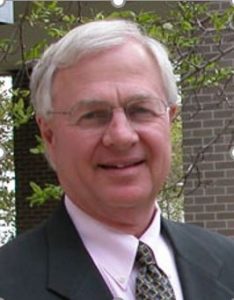
Allan Odden, Professor of Education Policy and Administration at USC, 1984-1993. Photo from CPRE website.
The PACE website lists Jerry Hayward, who served as chancellor of the California Community Colleges from 1980 to 1985, as a “Founder” as well as, in an earlier brochure, Allan Odden of the University of Southern California, who in 1986 became one of its co-directors. 19
Odden was to become not only a collaborator but also a friend of Mike’s, even staying at Mike’s home at times, especially after Stanford’s school of education joined another multi-university research group, the Consortium for Policy Research in Education (CPRE) in 1986.
Let’s listen in as Allan Odden describes his and Jerry Hayward’s start at PACE:
Audio Clip 5: Allan Odden: His start and tenure at the University of Southern California and role at PACE (27 seconds)20
As Mike recalls, Hayward was brought into the original leadership of PACE “because we needed somebody in Sacramento who really knew how that operated…as an on-the-ground presence,” adding, “If you’re gonna speak truth to power, then you want somebody who knows how power works.”21
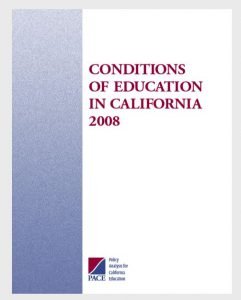
Cover of the most recent issue of PACE’s “Conditions of Education..” Photo from PACE website.
PACE released its first major publication, Conditions of Education, in 1984 while the researchers maintained a steady presence with key policymakers in Sacramento. At the time, “there was little else for policy-makers and the public to gauge the efficacy of any particular issue or policy.”22 Education thought leaders at the time, such as Diane Ravitch, who was then a Professor of Education at Teachers College, Columbia summarized, “PACE has emerged as a leading source of information about primary and secondary schooling in California. Conditions of Education is the preeminent sourcebook for information about the nation’s most populous state.” 23
Ted’s habit of talking to Mike and Jim, which started before and during the inception of PACE, continued for several years after he moved to the Stewart Foundation in 1985, first as its vice-president and then as its president.
As the PACE collaborators continued to explore and document conditions of schooling and learning in California, they came to agree that what happens in the classroom should not be viewed as separate from what the child experiences at home, and that the overall quality of life of children should be accounted for in setting policy. This led to PACE’s broader work and resulting publication, Conditions of Children.
Allan Odden, Mike’s PACE colleague at the time, speaks to this broadening perspective:
Audio Clip 6: Allan Odden: “Mike led the effort in California to consider the plight of children more broadly than just in education.” (21 seconds)24
This way of thinking more broadly about children in California also became a way of thinking and a priority for the Stuart Foundation under Ted’s leadership. Accordingly, the foundation contributed significant support to the broadened coverage of the 1989 PACE’s Conditions of Children. This expanded publication attempted to provide an overview of the quality of life of children in California by compiling information and synthesizing reports and other materials not readily available to policymakers at the time. Among other outcomes, this sparked interest and a focus on early childhood education in California that continues through today. Mike recalls that this 1989 expanded Conditions of Children, “was one of my proudest hours at PACE.” It drew upon the scholarly work of more than 27 authors and “covered nearly every aspect of children’s lives, [including] what music they listened to and their religious life.” 25
PACE became influential not only in how it brought research to bear on education policy in California but as a national model for other state education policy centers that eventually arose in over half of the states.26
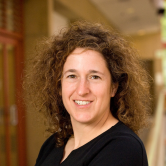
Susanna Loeb, PACE Faculty Director, 2005-2018. Photo from PACE website.
Let’s listen to Mike enthusiastically talking about his subsequent, more than two-decade involvement in PACE and what it has evolved into more recently–beginning with the addition of Susanna Loeb and David Plank at the helm in 2005 and 2007, respectively.
Audio Clip 7: Mike Kirst: “PACE is going really strong. The MBA/MA program [at Stanford] is one legacy [of mine]. The PACE program is another.” (33 seconds) 27
Among PACE’s most recent publications are:
- COVID-19 Impacts on Student Learning
- Student Well-Being and Learning Conditions During the Pandemic
- What’s Next for the Local Control Funding Formula?
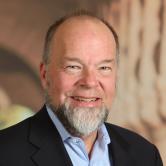
David Plank, Executive Director of PACE, 2007-2018. Photo from PACE website.
We’ll hear more about the Local Control Funding Formula later in this, and subsequent installments, which many believe is Mike’s most important legacy from his second tenure as California’s State Board of Education President with Governor Brown (2011-2019), and for which he is often referred to as “the father” of this major education reform for the country’s most populous state.28

Susan Fuhrman, Founder of CPRE. Photo from CPRE website.
As PACE continues to inform California leaders, it has also been a model for the establishment of other university policy think tanks in education. An early imitator was the Consortium for Policy Research in Education (CPRE), according to its founder in 1980, Susan Fuhrman, President Emerita, Teachers College, Columbia University, who was then at Rutgers University.29
Click here for a fuller treatment of PACE’s more recent history.
Second “Stanford” Back Story: Involving Two “Mike’s”
In the late 1970s and early 1980s, Stanford housed the federal educational research center, the Institute Research on Educational Finance and Governance (IFG), in which Mike Kirst had only a minor role amidst his teaching and advising roles in the School of Education. In addition, he was serving Governor Brown and establishing PACE. His research and publishing were also prolific.
In 1985, however, Stanford lost its bid to continue its federal funding for the IFG to a consortium of four other universities, the Consortium for Policy Research in Education (CPRE) noted above. One of the original four universities participating in CPRE was the University of Wisconsin at Madison, where Marshall “Mike” Smith was then the director of the Wisconsin Center for Education Research.
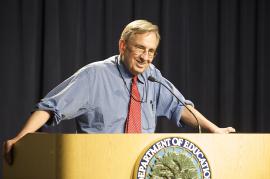
Marshall (Mike) Smith, former Dean of Stanford’s School of Education. Photo from Stanford’s Oral History Project.
Soon thereafter, in 1986, Stanford University recruited Mike Smith to become the Dean of the School of Education. Smith points out in an interview for Stanford that there was “a bit of irony” in this because shortly before that, “Wisconsin and Rutgers had taken the center from Stanford,” adding, “I was the director of that part of CPRE and one of the founders. Some of the money that I had at Wisconsin I brought to Stanford, not all of it, but some of it. So, Stanford joined CPRE.”30
In 1993, Mike Smith departed Stanford to join the Clinton administration as the undersecretary of education and acting deputy secretary of education.31 In a recent interview, the other Mike, Mike Kirst, recalls telling the irony of that transition, as well:
Audio Clip 8: Mike Kirst: “Smith…goes off to the Clinton administration and hands CPRE right to me.” (34 seconds)32
At that point, Kirst became a senior member of the CPRE team. Working closely with its founder and director, Susan Fuhrman, in its management and analyzing several attempted education reforms, including state standards reforms starting in the 1990s and in the following decades. This notably influenced his subsequent standards reform work in California, and beyond.
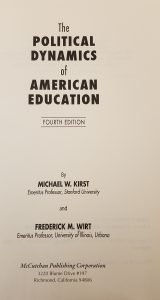
Photo from the book’s title page. Photo from Dick Jung.
Much earlier in Fuhrman’s training, Mike’s writings and interactions had a profound influence on her. She writes, “As an education policy graduate student at the University of California, Berkeley, between 1970-1972, I used his edited volume, The Politics of Education at the Local, State, and Federal Levels… During that period, he was finalizing his cornerstone book, The Political Web of American Schools with Fred Wirt. Subsequently, that book became the bible of the emerging fields of education policy and politics… The book, in its subsequent versions and later iterations, (The Political Dynamics of American Education, last revised in 2009), is without equal; the foundational textbook in the field. Its importance cannot be overstated.”33
“Follow The Publications”
“Follow the money,” is a common refrain for investigative journalists. “Follow the publications” is a worthwhile take-off of this dictum for a biographer of Mike Kirst, especially during this interregnum period between his first and second stint as president of California’s State Board of Education, that is the 28 years between these two “reigns.”
As noted earlier in this installment, Mike’s current resume shows an astounding 249 publications from the years 1982 to 2010.
Notable Trends in Mike’s Writings During this Period

Julia E. Koppich, President of J. Koppich & Associates. Photo from PACE website.
It’s not surprising that many of these publications, nearly 1 of 10, during this period are related to Mike’s PACE work in California; most of which were written or published with the earlier named PACE colleagues, including Jim Guthrie (14 publications), Allan Odden (6 publications), Jerry Hayward (5 publications), Julia Koppich (6 publications), and in later years during this interregnum period, Jacob Adam (3 publications). Mike’s PACE publications addressed a wide variety of topics, featuring school finance and governance, opinion polls about education, school leadership, and education reform in general. Specific topics such as voter ballot issues pertaining to K-12 education such as Proposition 13 and Proposition 174, special education, class size, and school choice (including vouchers, charter schools, and homeschooling) were also featured.
Later in this interregnum period, two topics that were to foreshadow a turn or two in Mike’s research, publications, and thinking, which become increasingly important in subsequent stages of Mike’s professional life, as he was rethinking categorical education programs (for specific groups of students–i.e., for poor backgrounds, with special needs) and the states’ establishment of measurable education standards in key learning areas.
The breadth of this work demonstrates PACE’s attention to the needs of Sacramento policymakers, as Mike noted above, “We were really oriented around going to the state capital and saying [to policymakers]: ‘What do you need to know?’ and ‘What policy programs are on your agenda that we can work on?'”
In addition, we see his list of collaborators growing, as he and co-authors build on each other’s investigations and observations. And thirdly, we note that updates to address evolving issues or news are common. For example, during this period, the most widely used textbook on the politics of education, Schools in Conflict: Political Turbulence in American Education, co-authored with Frederick Wirt, first published in 1982, and by 1992 had already been updated and revised in a second and third edition.
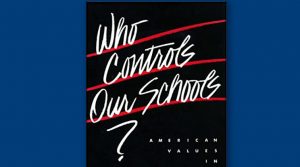
Photo of the book cover published in the Portable Stanford series.
Similarly, his most widely read book, Who Controls Our Schools: American Values in Conflict, was first published as part of the Portable Stanford series and then distributed by John Wiley Press in 1984. Written earlier when Mike was president of the California State Board of Education, the book emphasized “the notable state-to-state variation in educational policymaking and the interlocking, dynamic nature of federal, state, and local relationships in education.”
Another of Mike’s books published during this interregnum era, again, with co-authors, extends his influence beyond the U.S. into the international realm: Contemporary Issues in Education: Perspectives from Australia and U.S.A. written with his colleagues Greg Hancock and David Grossman and published by McCutchan Press in 1983. Because little attention has been paid to Mike’s international education activities and publications, we will more fully document his work outside of the United States, which started in Hong Kong in the early 1980s, in a separate, subsequent full installment.
So, to conclude this installment, we continue to “follow the publications” path through the initial interregnum years of 1982 to 2000 stateside with two other of Mike’s closest colleagues.
Two Other Notable Co-Author Stories
Mike collaborated extensively with five researchers, displayed below according to the longevity of their publication history with him (to date), according to his current resume:
- Fred Wirt: 7 publications over a 37-year period–1972 to 2009, (when he died);
- Susan Fuhrman: 7 publications over a 27-year period–1980 to 2007;
- Jim Guthrie: 14 publications over a 22-year period–1975 to 1997;
- Michael Usdan 3 publications over a 19-year period–1986 to 2007;
- Andrea Venezia: 10 publications over a 17-year period–2001-2018.
We have touched thus far on the three longest-serving collaborators–Fred Wirt, Susan Fuhrman, and Jim Guthrie–noting that his work with Fred Wirt for more than three decades led to the publication of the “bibles of the emerging fields of educational policy and politics.”34
Let’s complete our journey on the “publication trail,” by highlighting Mike’s work with Mike Usdan and Andrea Venezia.
The two others–Mike Usdan and Andrea Venezia–deserve further treatment regarding their connections with Mike and their important interactions and work in these earlier interregnum years (1982-2000)–with issues still quite salient today, including the roles and plight of the local school boards in America’s 16,000 school districts (before and during the start of this period) and the often “great divide between our country’s secondary schools and postsecondary education.”35
A “Way Back” Story: Involving Another Mike: Mike Usdan
During the early interregnum period, Mike Usdan, then President of the Institute for Educational Leadership, and Mike Kirst first produced ground-breaking analyses and summaries about the nation’s thousands of local districts; most importantly examining and describing the work of their school boards.
During this interregnum period, they published, according to Mike’s resume:
- School Boards: Strengthening Grass Roots Leadership (Washington, D.C.: Institute for Educational Leadership, 1986), with Michael Usdan and others;
- Governing Public Schools: Changing Times and Changing Requirements (Washington, D.C.: Institute for Educational Leadership, 1992) with J. Danzberger and M. Usdan; and
- “The History of the Separation of Elementary, Secondary, and Postsecondary Education,” in Nancy Hoffman (ed.), Minding The Gap (Cambridge, MA: Harvard Education Press, 2007), with Michael Usdan.
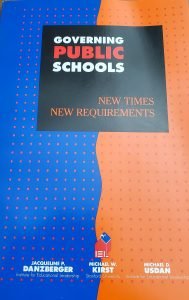
Cover of Institute for Educational Leadership’s monograph documenting the plight of and the need to reform America’s local school boards.
The first two of these, published within a few years of each other, assessed the role and traced the plight of these local school boards, noting that they were part of the “marble cake” governance structure of America’s K-12 education system. Their powers had been limited by a number of realities–including the shift of financing public schools more to the state level, federal requirements that came with the increased categorical funding of federal and state education programs for special groups of students (i.e., in areas of relatively high poverty areas and handicapped students), and related court decisions. C-SPAN produced an hour-long broadcast, drawing on the second of these two publications, Governing Public Schools: Changing Times and Changing Requirements, in the fall of 1992. This video clip contains some of the earliest publicly available video footage of Mike Kirst.
We include an excerpt from the C-SPAN broadcast below. In it, Mike Usdan sets the stage and introduces Mike Kirst, who summarizes a most notable but often overlooked trend for local school boards they had documented. The clip is longer than the previous audio clips in this installment, but very much worth watching, listening to, and thinking about for today’s public k-12 schools. Let’s watch and listen in:
After summarizing four disturbing trends for local school boards over time, including the high turnover of school superintendents in urban areas, Mike concludes with this poignant assessment: “The biggest loser in educational politics in the last 35 years has been the school boards. Everybody else has gained power at their expense: federal government, state governments, courts, interstate testing organizations, unions, and all sorts of special interest groups that have been formed at the local level. So, the school boards have been squeezed into this narrow zone of discretion.”
These observations about school boards in 1992 are probably even more true today.
In an upcoming installment, we’ll hear more about how Mike–now in his 80’s–draws today on his and Usdan’s research to advise a San Francisco citizens group and others as they consider initiating a referendum to improve the operations of their school board. Relatedly, we treat what Mike calls the “cyclical nature” of the education policy in an upcoming installment.
Mike (Usdan), Mike (Kirst), and Andrea Venezia Connections
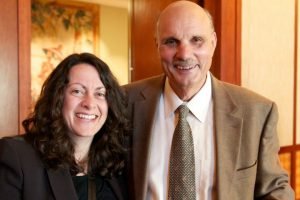
Andrea Venezia with Mike Kirst. Photo from Dick Jung.
The third Usdan-Kirst publication in our list, The History of the Separation of Elementary, Secondary, and Postsecondary Education,36 includes Andrea Venezia, who later becomes established as a nationally recognized expert in an emerging field and education policy, the “K-16 Period.” This collaboration helped Mike recognize the interrelatedness, or disturbing lack thereof, of the K-12 and postsecondary sectors of American education and the ways those disjunctures can undermine American’s school-aged children’s aspirations. 37
In the next installment, covering the second two decades of these interregnum years (2000-2010), we will learn much more about Mike’s work with Andrea and the ways he prepared himself to tackle the new-for-him topic of post-secondary education.
In this exploration of the first two decades of the interregnum period, (between his two periods of service in the Brown administration), we have seen Mike’s portfolio widen and deepen. He has broadened the way policymakers approach education (noting other influences on children’s lives); he has established an enduring vehicle by which state policymakers can learn from university-based research; he has enlightened us about the ever-growing complications in the operations of local school boards; he has laid the groundwork for more robust examinations of K-12 and postsecondary education sectors, and he has examined what American policy-makers can learn from the education enterprise in other countries.
We invite you to check out the next installment as well, in which we will highlight Mike’s K-16 work, his work with Brown as the Mayor of Oakland (from 1999 to 2007), the developments which led to California’s embrace and leadership in the country’s education standards movement, and the reforms related to the Local Control Funding Formula for which he is probably most known, at least in California and other policy circles.
Editor’s Note: The Appendix for “Conversations With and About Mike” contains transcripts for the recorded audio and video clips. To view the Audio Transcripts go to this page >
Footnotes
- Mike Kirst’s Autobiographical Reflections, June 9, 2014, presentation for the Stanford Emeriti Council. Republished February 5, 2015, by Stanford’s Center for Education Policy Analysis. https://searchworks.stanford.edu/view/nc116hr7647
- Proposition 13 was an amendment to the California Constitution passed by voter initiative in June 1978 that limited property taxes, until then the major source of school funding. See EdSource’s glossary for further explanation: https://edsource.org/glossary/proposition-13
- Mike Kirst interview with Anita Hecht, November 19, 2013, for The States’ Impact on Federal Education Policy Oral History Project.
- Mike Kirst interview with Anita Hecht, November 19, 2013, for The States’ Impact on Federal Education Policy Oral History Project.
- https://www.google.com/searchq=interregnum&rlz=1CDGOYI_enUS776US776&oq=interregnum&aqs=-chrome..69i57.5057j0j4&hl=en-US&sourceid=chrome-mobile&ie=UTF-8#cobssid=s
- https://www.educationnext.org/supersized-rhsus-2010-edu-scholar-public-presence-rankings/
- Mike Kirst’s Autobiographical Reflections, June 9, 2014, presentation for the Stanford Emeriti Council. Republished February 5, 2015, by Stanford’s Center for Education Policy Analysis. https://searchworks.stanford.edu/view/nc116hr7647
- Mike Kirst’s “Autobiographical Reflections,” June 9, 2014, presentation for the Stanford Emeriti Council. Republished February 5, 2015, by Stanford’s Center for Education Policy Analysis. https://searchworks.stanford.edu/view/nc116hr7647
- The original name of PACE according to the Policy Analysis for California (PACE) website PACE initially stood for “Policy Alternatives for California Education.” https://edpolicyinca.org/about/history
- Current members of PACE include Stanford University, the University of Southern California, the University of California Davis, the University of California Los Angeles, and the University of California
Berkeley. https://edpolicyinca.org/ - Mike Kirst’s Autobiographical Reflections, June 9, 2014, presentation for the Stanford Emeriti Council. Republished February 5, 2015, by Stanford’s Center for Education Policy Analysis. https://searchworks.stanford.edu/view/nc116hr7647
- Fulton, S. (January 18, 1984) Calif. Scholars Launch Project to Better Understanding of Education. Education Week.
- Mike Kirst’s Autobiographical Reflections, June 9, 2014, presentation for the Stanford Emeriti Council. Republished February 5, 2015, by Stanford’s Center for Education Policy Analysis, https://searchworks.stanford.edu/view/nc116hr7647
- https://edpolicyinca.org/about/history
- These two publications in Mike’s resume summarize his work in the 1970s with his colleagues in the states of Florida and Oregon, respectively are: Revising School Finance in Florida (Tallahassee: Florida Governor’s Office, 1973), with W. Garms, and; State School Finance
Alternatives (Eugene, Oregon: University of Oregon, 1975), with L. Pierce, W. Garms, and J. Guthrie - Email correspondence from Ted Lobman December 7, 2021.
- Ted Lobman interview with the author, December 8, 2021.
- Ted Lobman interview with the author, December 8, 2021.
- https://edpolicyinca.org/about/history and “PACE Looking Back and
Looking Forward: 25th Anniversary Celebration 1983-2008,” unpublished and undated brochure, respectively. - Allan Odden interview with the author, October 12, 2018.
- Mike Kirst interview with the author, December 1, 2021.
- https://edpolicyinca.org/about/history
- PACE: Looking Back, Looking Forward, 25th Celebration 1983-2008. 25th Anniversary brochure, unpublished and undated brochure.
- Allan Odden interview with the author, October 12, 2018.
- Mike Kirst interview with the author, November 22, 2021
- Fuhrman, S. (July 2021). Recommendation letter for Mike Kirst’s nomination for Education Commission of the States 2021 James Bryant Conant Award, (unpublished letter).
- Mike Kirst interview with the author, December 1, 2021.
- https://edsource.org/2013/michael-kirst-father-of-new-school-funding-formula-looks-back-and-at-the-work-ahead/33408 and https://www.youtube.com/watch?v=DrQB63VkWcY
- Fuhrman, S. (July 2021). Recommendation letter for Mike Kirst’s nomination for Education Commission of the States 2021 James Bryant Conant Award, (unpublished letter).
- Marshall (Mike) Smith (2016) Oral History. Stanford Historical Society Oral History Program Interviews (SC0932). Department of Special Collections & University Archives, Stanford University Libraries, Stanford, Calif.
- https://historicalsociety.stanford.edu/publications/smith-marshall-smike
- Mike Kirst interview with the author, December 1, 2021.
- Fuhrman, S. (July 2021). Recommendation letter for Mike Kirst’s nomination for Education Commission of the States 2021 James Bryant Conant Award, (unpublished letter).
- Fuhrman, S. (July 2021). Recommendation letter for Mike Kirst’s nomination for Education Commission of the States 2021 James Bryant Conant Award, (unpublished letter).
- This phrase is devised from the title of a publication co-authored by Mike Kirst and Andrea Venezia in Phi Delta Kappa, No. 3, Volume, September 2001, entitled “Bridging the Great Divide Between
Secondary Schools and Postsecondary Education.” - Hoffman, N. (2007). Minding the Gap. Cambridge, MA: Harvard
Education Press. - This phrase is devised from the title of a publication co-authored by Andrea Venezia, Michael Kirst, and Anthony Antonio: Betraying the College Dream… https://web.stanford.edu › ncpi › documents › pdfs
